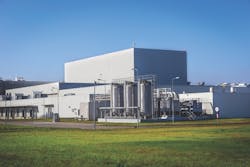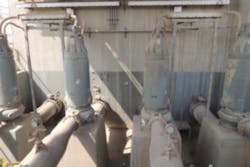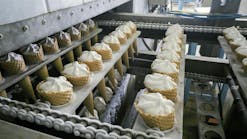Industrial wastewater is a major challenge in processing industries. In fact, some processing projects have not been implemented due to the high costs or difficulties associated with their industrial wastewater treatment. Large-scale environmental initiatives have taken place in many countries, resulting in strict environmental regulations on industrial wastewater discharge. While operators may have installed industrial wastewater treatment systems to meet local regulations when built, they needed expensive upgraded programs to meet new challenging limits and tighter regulations introduced later. Some could not even reach those tight limits after vast modifications.
Industrial wastewater usually contains a range of organic and inorganic matters in varying concentrations. Many materials are toxic, mutagenic, carcinogenic or almost nonbiodegradable. This means that the wastewater also contains a range of substances that cannot be easily degraded.
Primary treatment involves the removal of solids, particles and oils in the industrial wastewater stream; therefore, primary treatment usually contains basic physical methods and solid/oil separations such as primary clarifiers, oil separators and screens. Secondary treatment is usually the heart of the treatment unit where suspended and residual organics and compounds are broken down. Secondary treatment usually involves biological (bacterial) degradation of contaminations and pollutants. Aerated activated sludge treatment has been known as one of the best solutions for secondary treatment. It is simple, cost-effective and high-performing.
Combinations of anaerobic and aerobic treatment processes have been found to be efficient in the removal of many pollutants such as soluble biodegradable organic pollutants. The use of membrane-based technologies in industrial wastewater treatment is increasing. Chemical oxidation techniques to treat wastewater are also on the rise because of tighter treated wastewater limits. Both classical chemical treatment and advanced oxidation processes have been used in modern industrial wastewater units. Tertiary treatment usually includes final filter steps, polishing and finishing stages, e.g., widely used activated carbon filters.
This article highlights industrial wastewater treatment technologies, including physicochemical, biological and advanced oxidation processes, used in processing industries.
Oil removal
Conventional approaches to treating oily wastewater have included gravity separation and skimming, dissolved air flotation (DAF), de-emulsification, coagulation and flocculation. Gravity separation followed by skimming is effective in removing free oil from industrial wastewater. Oil-water separators such as the API separator and its variations have found widespread acceptance as an effective, low-cost primary treatment step. The API oil-water separator is designed to separate the oil and suspended solids from wastewater. An API separator or other basic oil-water separator, however, is not effective in removing smaller oil droplets and emulsions. Oil that adheres to the surface of solid particles can be effectively removed by sedimentation in a primary clarifier.
DAF is one of the most effective methods to treat small oil droplets and emulsions. DAF uses air to increase the buoyancy of small oil droplets and enhance separation. Emulsified oil in DAF is removed by de-emulsification with chemicals, thermal energy or both. DAF units typically employ chemicals to promote coagulation and increase flock size to facilitate separation. Emulsified oil in industrial wastewater is usually chemically pretreated to destabilize the emulsion followed by gravity separation. The wastewater is often heated to reduce viscosity, accentuate density differences and weaken the interfacial films stabilizing the oil phase. This is followed by acidification and the addition of cationic polymer/alum to neutralize the negative charge on oil droplets, followed by raising the pH to the alkaline region to induce flock formation of the inorganic salt. The resulting flock with the adsorbed oil is then separated, followed by sludge thickening and sludge dewatering.
Coagulation and flocculation
Most industrial wastewater treatment units include sedimentation in their processes. Sedimentation, also called clarification, is a treatment process in which the velocity of the wastewater is lowered below the suspension velocity, and the suspended particles settle out of the wastewater due to gravity. Settled solids are removed as sludge, and floating solids are removed as scum. Industrial wastewater leaves the sedimentation tank over an effluent weir to the next step of treatment. The efficiency or performance of the process is controlled by retention time, temperature, tank details and other factors. However, without coagulation/flocculation, sedimentation can remove only coarse suspended matter that will settle rapidly out of the wastewater without the addition of chemicals. This type of sedimentation typically takes place in a reservoir, sedimentation or clarification tank at the beginning of the treatment process. Coagulation/flocculation is based on the addition of chemical products that accelerate the sedimentation (coagulants) in the clarification tanks. The coagulants are inorganic or organic compounds such as aluminum sulphate, aluminum hydroxide chloride or high molecular weight cationic polymer. The purpose of adding coagulant is to remove almost 90 percent of the suspended solids from industrial wastewater at this stage in the treatment process.
A set of vertical pumps used in the transfer of wastewater to a wastewater treatment unit.
Graphic courtesy of Amin Almasi
Biotreatment for wastewater treatment for processing plants
Biological processes deal primarily with organic impurities. Microbial-based technologies have been used over the last century for the treatment of industrial wastewater. The development of these technologies has provided successful processes for the destruction of waste constituents readily biodegradable under aerobic conditions.
Aerobic degradation in the presence of oxygen can be a relatively simple, inexpensive and environmentally friendly way to degrade wastes. Factors that are critical in the optimal degradation of the selected substrate include temperature, moisture, pH, nutrients and aeration rate that the bacterial culture is exposed to, with temperature and aeration as two of the most critical parameters that determine the degradation rates by the microorganism.
Soluble organic sources of biochemical oxygen demand (BOD) can be removed by any viable microbial process — aerobic, anaerobic or anoxic. However, aerobic processes are typically used as the principal means of BOD reduction of wastewater because the aerobic microbial reactions are fast — typically 10 times faster than anaerobic microbial reactions. Therefore, aerobic reactors can be built relatively small and open to the atmosphere, yielding the most economical means of BOD reduction.
On the other hand, the major disadvantage of aerobic bioprocesses for wastewater treatment, relative to anaerobic processes, is the large amount of sludge produced. A relatively high accumulation of biomass occurs in the aerobic bioreactor because the biomass yield (mass of cell produced per unit mass of biodegradable organic matter) for aerobic microorganisms is relatively high — almost 3 to 4 times greater than the yield for anaerobic organisms. The sludge present in the reactor effluent can contain residual BOD that may need to be reduced in an additional process and should ultimately be disposed of as a solid waste.
Many mechanisms can be used by the microorganisms during the aerobic degradation process, such as the attack on the xenobiotics by organic acids produced by the microorganisms, the production of noxious compounds such as hydrogen sulphide, and the production of chelating agents, which are able to increase the solubility of any insoluble xenobiotics, making them more available to the microorganisms and mechanical degradation.
Some industrial wastewater may exert a toxic effect on the microorganisms present in a conventional activated sludge reactor. Contaminations and compounds found in these wastewater streams cannot be used as a sole carbon source by microorganisms and will vary in toxicity. Therefore, inhibition of growth of the microorganisms by these components play a crucial role in the degradation process because this can cause the treatment system to fail.
The key to successful biotreatment technology of some industrial wastewater is to modify or optimize the cell and substrate contact time so that biodegradation can proceed in a reasonable time and potential toxicity of the wastewater to bacteria and microflora is reduced.
"Anaerobic reactors differ from aerobic reactors primarily because the former should be closed to exclude oxygen from the system to avoid interference with anaerobic metabolism."
Activated sludge treatment methods have been widely used to treat industrial wastewater. New technologies of membrane bioreactors (MBR) that have been inoculated with activated sludge have shown to effectively treat high-strength organic wastewater. On the other hand, the two-phase partitioning reactor has also been effective with toxic substrates.
Anaerobic reactors differ from aerobic reactors primarily because the former should be closed to exclude oxygen from the system to avoid interference with anaerobic metabolism. An anaerobic reactor should be provided with an appropriate vent or a collection system to remove the gases (mainly methane and carbon dioxide) produced during anaerobiosis.
Anaerobic microbial processes have several advantages:
- Lower production rate of sludge
- Operable at higher influent BOD and toxic levels
- No cost associated with delivering oxygen to the reactor
- Production of a useful byproduct, methane (biogas)
However, anaerobic processes have higher capital and operating expenses than aerobic processes because the anaerobic systems should be closed and usually heated. Anaerobic bioprocesses for treatment of hazardous wastewater streams are typically limited to treatment of low flow rate streams, or additional provisions should be provided.
Anaerobic digestion consists of several interdependent, complex sequential and parallel biological reactions, during which the products from one group of microorganisms serve as the substrates for the next, resulting in transformation of organic matter mainly into a mixture of methane and carbon dioxide. Anaerobic digestion takes place in four phases: hydrolysis/liquefaction, acidogenesis, acetogenesis and methanogenesis. To ensure a balanced digestion process, the various biological conversion processes should remain sufficiently coupled during the process to avoid the accumulation of any intermediates in the system. Anaerobic reactors such as up-flow anaerobic sludge blanket (UASB) and anaerobic sequencing batch reactor (ASBR) have been used for industrial wastewater treatment.
Advanced oxidation processes for wastewater treatment for processing plants
Oxidation, by definition, is a process in which electrons are transferred from one substance to another, leading to a potential expressed in volts referred to as normalized hydrogen electrode. From this, oxidation potentials of the different compounds are obtained. Chemical oxidation appears to be a solution that complies with treated wastewater legislation. It is usually used after a secondary treatment for the destruction of nonbiodegradable compounds. A reference parameter in using chemical oxidation as a treatment process is the chemical oxygen demand (COD). Usually, wastewater with relatively small COD contents can be suitably treated by these processes since higher COD contents would require the consumption of excessive amounts of expensive reactants. The chemical oxidation processes can be divided into two classes:
- Classical chemical treatment
- Advanced oxidation processes (AOPs)
AOPs are defined as near ambient temperature and pressure wastewater treatment processes that involve the generation of highly reactive radicals (especially hydroxyl radicals) in sufficient quantity for wastewater purification. These treatment processes are promising methods for the remediation of contaminated ground, surface and waste water containing nonbiodegradable organic pollutants. Hydroxyl radicals are extraordinarily reactive species that attack most of the organic molecules.
AOPs face some limitations — technical and economical — in their application. Particularly, there are serious limitations in applying them to whole-site wastewater flow or using them in permanent operation. For some large critical treatment units, AOPs are required to deal with peak COD to meet strict treatment limits. These units are most often used after biotreatment. AOPs are also quite effective in converting rather recalcitrant compounds into intermediates amenable to biological oxidation via recirculation to the inlet of the biological unit or, even better, completely mineralizing these compounds when applied in the outlet of a biological treatment facility as a final polishing step.
Among AOPs, Fenton’s reagent has been found to be effective in treating industrial wastewater components including aromatic amines, a variety of dyes as well as other substances, e.g., pesticides and surfactants. One advantage of Fenton’s reagent is that no energy input is necessary to activate hydrogen peroxide.
Amin Almasi is a senior machinery and equipment consultant. He is a chartered professional engineer of Engineers Australia and IMechE. Almasi is an active member of Engineers Australia, IMechE, ASME and SPE, and he has authored more than 150 papers and articles on rotating equipment, condition monitoring, offshore, water treatment, wastewater treatment and reliability.




